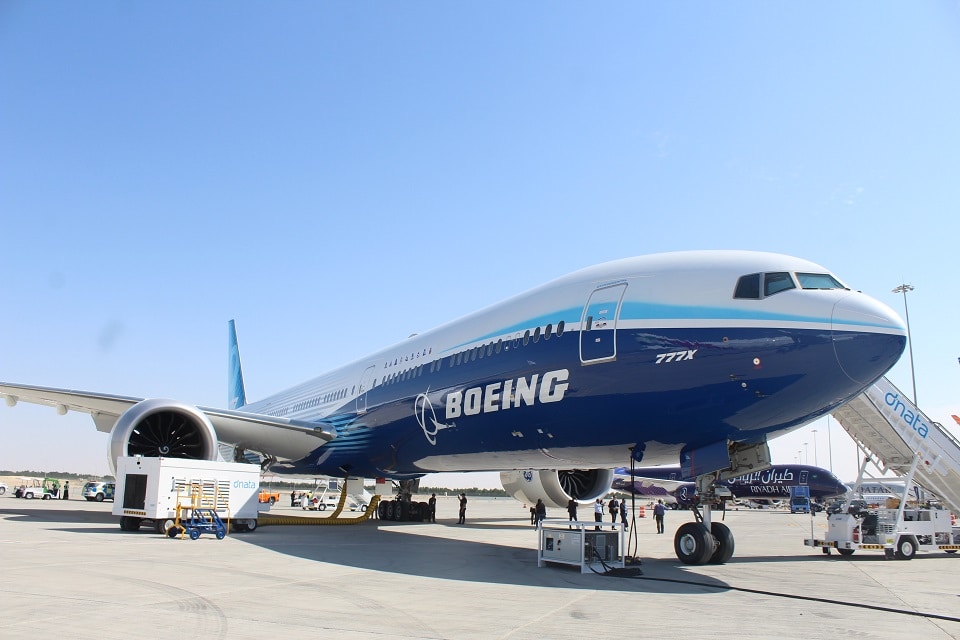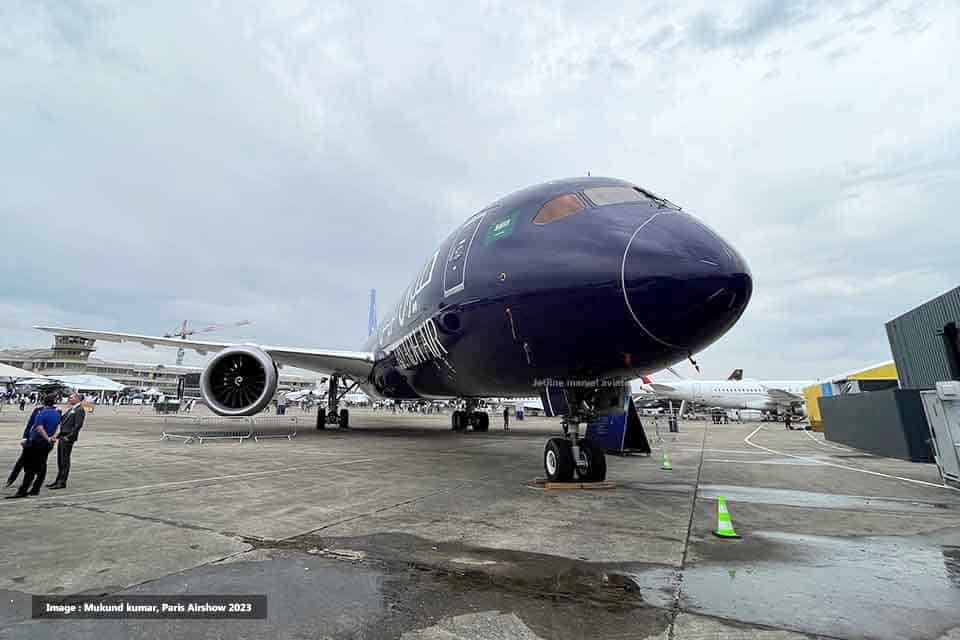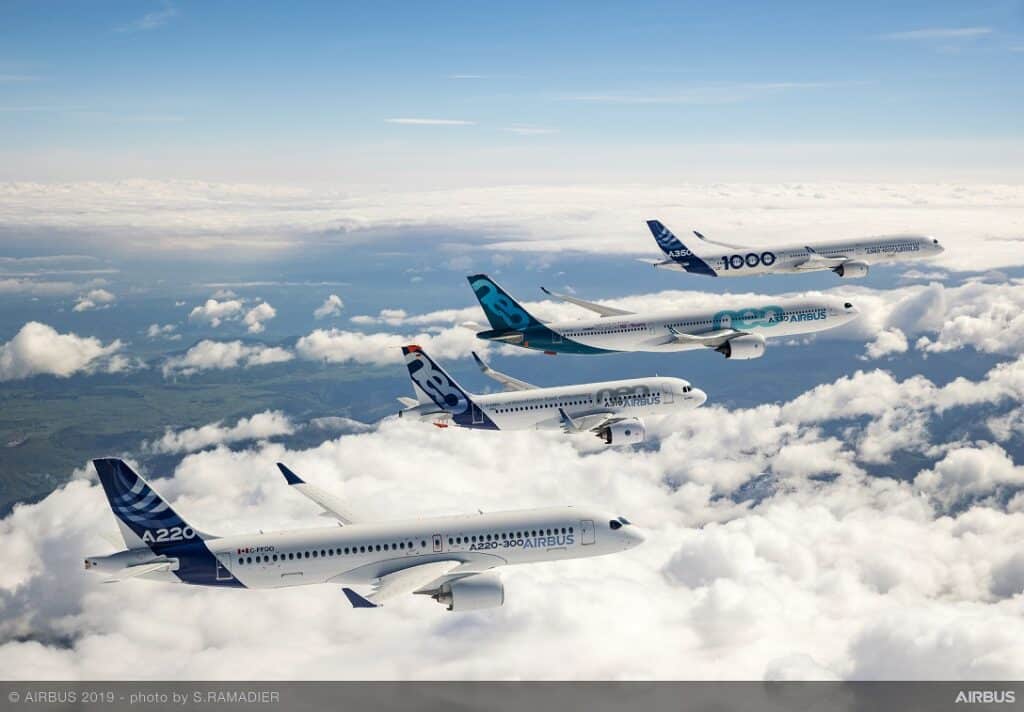Aerospace
The total aircraft orders for Boeing and Airbus at the Dubai Airshow 2023 : Day 5

Boeing made a significant impact at the Dubai Airshow, unveiling numerous anticipated aircraft orders from various airlines. Notably, the Boeing 777X, 787, and Boeing 737 MAX received substantial orders, adding to the excitement of the event.
Meanwhile, Airbus celebrated successes as well, securing orders from Airbaltic, a valued customer that has now become one of the largest operators of Airbus A220 aircraft. Additionally, both Egyptian and Ethiopian Airlines made noteworthy commitments at the Dubai Airshow 2023 by ordering 21 Airbus A350-900 aircraft on 3rd day.
After receiving assurances from the engine manufacturer, Emirates placed new orders for A350 aircraft at the Dubai Airshow on the fourth day, despite an engine issue. Let’s delve further into these airlines and their contributions to this aviation showcase.

Boeing
Day 1
SunExpress orders 90 aircraft.
The airline made a significant commitment by ordering up to 90 airplanes, including a mix of 737-8s and 737-10s. SunExpress, a joint venture between Turkish Airlines and Lufthansa, has a long history of ordering from Boeing, and this new agreement includes 45 firm orders and 45 options, with 28 of them being for the MAX 8 and 17 for the MAX 10.
Emirates placed 125 aircraft order
Emirates, the world’s largest 777 operator, placed an impressive order for 125 aircraft. This order includes 35 Boeing 777-8s, 55 777-9s, and 35 787s. This substantial addition to their fleet brings Emirates’ total 777X family backlog to 205 planes.
Their relationship with Boeing dates back to 1992 when they placed their first 777 order, and they now have nearly 150 777 jets in their fleet.
Emirates also adjusted its 787 Dreamliner order book, increasing it by five 787 jets to a total of 35, while converting 30 787-9s to 20 787-8s and 10 787-10s.
Fly Dubai orders 30 aircraft.
FlyDubai diversified its fleet by ordering 30 Boeing 787-9 Dreamliner jets, marking their entry into widebody aircraft operations. The airline plans to utilize the efficient 787s to open new routes and increase capacity on existing ones. FlyDubai, which currently operates a fleet consisting entirely of 737s, emphasized the significance of this $11 billion deal in supporting Dubai’s aviation hub.
Royal Jordanian orders 4 Boeing 787
Four 787-9 Dreamliner aircraft were added to Royal Jordanian’s widebody fleet, and the airline confirmed an earlier order for two more 787-9s during the Dubai Airshow, increasing its total 787-9 backlog to six.
Royal Air Maroc orders 2 Boeing 787 aircraft.
Royal Air Maroc confirmed an order for two 787-9 Dreamliners, reinforcing their commitment to expanding their widebody fleet. Currently operating nine Dreamliners, the airline values the efficiency and flexibility offered by the 787 family.
Air Lease Corp orders18 Boeing 737 max 8
In another development, EgyptAir signed a lease agreement with Air Lease Corporation for 18 Boeing 737 MAX 8 aircraft, though Boeing has yet to make an official announcement. The contract was signed with Air Lease Corporation.
DAY 2
SCAT Airlines orders 7 Boeing 737 MAX
It is the first airline in Central Asia to fly the 737 MAX and currently operates three 737-8 and five 737-9 airplanes.
Ethiopian Airlines orders 31 Boeing aircraft.
Ethiopian Airlines today announced the carrier has agreed to order 11 787 Dreamliners and 20 737 MAX airplanes with an opportunity for 15 and 21 additional jets, respectively. The agreement, signed by Ethiopia’s national carrier at the Dubai Airshow, represents the largest-ever purchase of Boeing airplanes in African history.
Day 3 – 0
Day 4 – 0
Day 5 – 0 orders
List of Boeing aircraft orders
- -Boeing 777x family – 90 aircraft
- -Boeing 787 family – 82 aircraft
- -Boeing 737 Max family – 135 aircraft

Airbus
Day 1
Airbaltic Orders 30 Airbus A220 Aircraft
Airbus received a substantial order from airBaltic, solidifying an agreement for 30 Airbus A220-300 aircraft, with an option for an additional 20. This positions airBaltic as a leading A220 customer in Europe and the foremost A220-300 operator globally, aligning with their goal to operate a fleet of 100 Airbus aircraft by 2030.
Day 2
EGYPTAIR announces order for 10 A350-900
The airline has firmed up an agreement with Airbus to procure 10 A350-900 aircraft, each boasting a capacity of 340 seats. These aircraft come equipped with cutting-edge technologies and Rolls-Royce XWB Trent engines, known for their modern design and reduced fuel emissions and consumption. As we tackle growing demand across our network, this aircraft is the optimal choice.
Day 3
Ethiopian Airlines orders 11 A350-900 aircraft
Ethiopian Airlines in it for the long-haul: commits to a further 11 A350-900s to be added to its existing fleet. The latest agreement takes Ethiopian Airlines’ total order book and commitment for the A350 to 33, including four A350-1000s.
Day 4
Emirates orders 15 A350-900 aircraft
Emirates has signed an order for an additional 15 A350-900s at the Dubai Airshow, taking its total order to 65 aircraft.
The A350 is the world’s most modern and efficient widebody aircraft and the long-range leader in the 300-410 seater category, flying efficiently on any sector from short-haul to ultra-long-haul routes up to 9,700nm. The first A350 is scheduled to join Emirates’ fleet in August 2024
Day 5 – 0 orders
List of Airbus aircraft orders
- – Airbus A220 – 30
- – A350-900 – 36
Conclusion.
Boeing and Airbus have reported positive developments in their upcoming aircraft order books, with Boeing securing a greater number of orders compared to Airbus. Boeing’s success is attributed to significant orders for its B787, 777x, and 737 Max aircraft from various stakeholders and airlines. Airbus, while facing some challenges with the A350-1000 due to engine issues that led to missed orders from Middle East customers, still received substantial orders for the A350-900 and Airbus A220 aircraft.
Both companies showcased impressive static displays and flying demonstrations of their aircraft, drawing the attention of visitors at events like the Dubai Airshow. The aerospace industry witnessed numerous Memoranda of Understanding (MOUs) being signed, indicating increased collaboration and potential business opportunities. Additionally, agreements were made to explore Maintenance, Repair, and Overhaul (MRO) opportunities in new locations, further expanding the scope of the industry.

Aerospace
When Ratan Tata was denied entry to the airfield at the Aero India show, he waited

During our visit to Aero India 2019, we had the unexpected opportunity to see Ratan Tata at the event, which was a thrilling moment for us. However, there was a surprising hiccup when the security staff didn’t allow him to enter due to a lack of a security pass.
Despite this, he remained calm and patiently waited for about 20 minutes until a member of the Tata team brought him the required pass, after which he calmly proceeded inside. It was a humbling sight, showcasing his composed demeanor even in such situations.
Ratan Tata ji is not only a renowned industrialist but also a trained pilot, holding a pilot’s license. In 2007, he became the first Indian civilian to fly the F-16 Falcon during the Aero India show in Bangalore—a proud moment for the nation.
His passion for aviation extended beyond flying, as he played a key role in shaping India’s aerospace industry. Under his leadership, Tata ventured into manufacturing and maintaining aerospace components while upholding its legacy of quality. Notably, Tata’s collaboration with Airbus to develop and manufacture the C295 aircraft is a testament to its growing influence in the sector.
-

 Aviation2 months ago
Aviation2 months agoMicrosoft Flight Simulator Raises $3 Million to Bring Back the An-225 Mriya
-

 Airlines2 months ago
Airlines2 months agoQantas Engineers Stage Walkout Over Cost of Living Concerns
-

 Airlines2 months ago
Airlines2 months agoQatar Citizens Can Travel to the United States Without a Visa
-

 Aviation2 months ago
Aviation2 months agoQatar Airways bans these new Electronic Devices on plane
-

 Airlines2 months ago
Airlines2 months agoJapan Airlines Rolls Out Free Domestic Flights to International Passengers
-

 Defence2 months ago
Defence2 months agoWhich Country Has the Largest Fleet of Fighter Aircraft?
-

 Airport2 months ago
Airport2 months agoWestern Sydney Airport Welcomes Its First Plane After 6 Years of construction
-

 Aviation2 months ago
Aviation2 months agoDid you know ? Once Boeing 747 carried 1088 passenger in 1991








